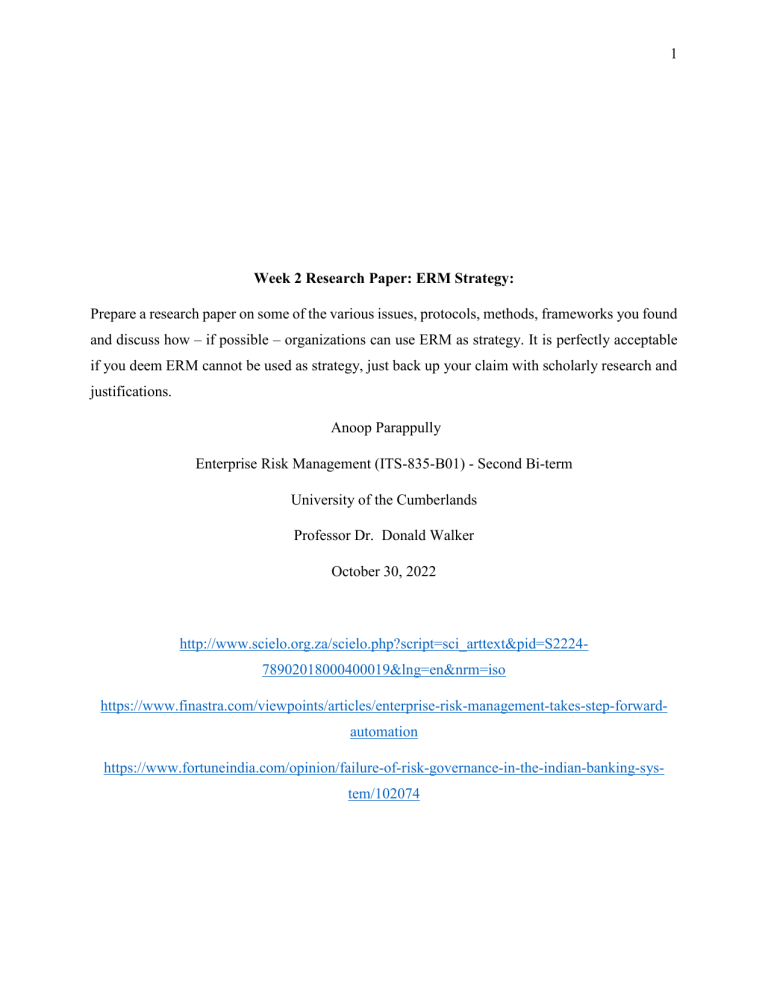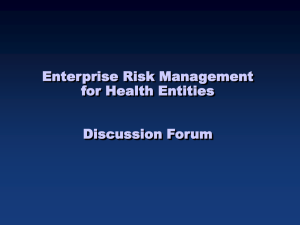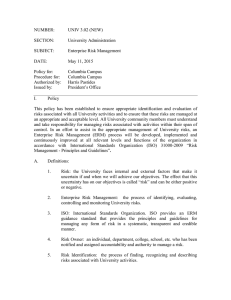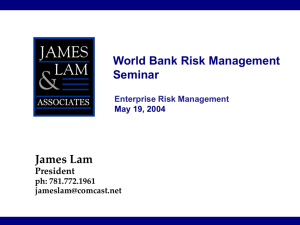
1 Week 2 Research Paper: ERM Strategy: Prepare a research paper on some of the various issues, protocols, methods, frameworks you found and discuss how – if possible – organizations can use ERM as strategy. It is perfectly acceptable if you deem ERM cannot be used as strategy, just back up your claim with scholarly research and justifications. Anoop Parappully Enterprise Risk Management (ITS-835-B01) - Second Bi-term University of the Cumberlands Professor Dr. Donald Walker October 30, 2022 http://www.scielo.org.za/scielo.php?script=sci_arttext&pid=S222478902018000400019&lng=en&nrm=iso https://www.finastra.com/viewpoints/articles/enterprise-risk-management-takes-step-forwardautomation https://www.fortuneindia.com/opinion/failure-of-risk-governance-in-the-indian-banking-system/102074 2 1. INTRODUCTION This research paper describes how ERM failed in the Indian banking system. Several banks went down due to the lack of risk governance strategies. For example, in Panjab National Bank, there was a significant threat to eliminate more than a quarter of shareholders' equity. It was because of a dishonest employee's move. Typically, banks implement ERM to avoid such situations. ERM was supposedly planned to use for risk management and risk governance. Every bank and insurance organization not only just implemented risk governance but also improvised their practices as and when needed in major countries in the world. However, India still follows the same old risk governance strategies defined a decade ago. ERM is considered an effective process to control risks in an organization with the help of a framework that depicts risk governance. But in this paper, we will see how ERM strategies have failed in the Indian banking system. ERM execution affects regulations, procedures, techniques, individuals, and many more. 2. BACKGROUND The development of big data analysis can benefit organizations like SAP for transformations. Big data generally shows massive and intricate components representing people’s occupations and is definable in phrases of measurements, research, operations, or company developments. SAP organizes data relevant to the organization from entities and stakeholders. The experienced team outlines the essential paradigms and big data analytics and their associations. The pursuing are the subsections as part of the background. 3 2.1 DESCRIBE THE ISSUE Here, I illustrate the challenges or problems; SAP encounters when Big Data or Business Intelligence was not in place. Firstly, the vision and classic thought operations on information apprehend, processing, and repository require to revise. This is an accumulative and gradual approach. Excavating such massive data demands data mining methodologies such as the information mining grid and Map lower infrastructure such as Hadoop. The technology might not be costefficient, and the understanding turn is abrupt. It even needs a non-linear, non-inevitable software architecture. Secondly, the famous saying ‘What we estimate is what we drive’ stands moderately elevated here. That means we ought to comprehend what we desire to estimate for daylight as an organization. We must understand what we are examining. If we wish to determine movement routines for the daytime and indicate a way a social exchange might guide, then we ought to understand ‘when to request the query. This is incredibly challenging as circumstances are vigorous. Social networks have a geometric metamorphosis design. Big data technologies and applications should be capable of mounting and exploring this comprehensive unstructured data. It should have the ability to analyze in real-time as it transpires. Social media businesses generate a ton of context to the details. Such context is a priceless resource for knowledge and expertise sharing. The context in conversations is a legend of a colonial network’s triumph. Investigating millions of informal news every day is not an effortless task. This is where standard analytics can support mainstream Big data research, and both ought to move hand in hand. 2.2 DISCUSS THE PROBLEM Over the past ten-year period, SAP has looted in-depth into big data with resolutions such as the SAP HANA in-memory database and SAP Data Intelligence conglomeration. With these 4 implements, enterprises can quickly collect and investigate terabytes of data, driving more reasonable corporation judgments. In the C-Suite, the understanding that SAP can endure big data data and structuring it in a way that forms. Two such fragments of details that are reasonable to learn are the notion of an information lake and the capacities of SAP Vora. 2.3 TECHNIQUES 2.4 ALGORITHMS The algorithm-based techniques for big data analysis in smart cities are examined, and the taxonomy of pertinent publications is presented and then summarized in the below Section. Algorithm-based systems are contained and offered for big data analysis in smart cities like primary benefits, weaknesses, central concepts, algorithm sorts, evaluation methods, devices, and case analyses detail the metrics employed in the literature, including price, availability, sustainability, duration, precision, scalability, healthiness, safety, throughput, feasibility, and 2.5 ARCHITECTURES In this first, the architecture-based techniques for big data research in smart cities are examined, and anatomy of pertinent publications is presented and then summarized. The articles in this area suggest an architecture to unravel problems and challenges. Then a synopsis of architecture established systems is given. Summary of the preferred architecture-based systems Tang introduced a hierarchically split fog computing architecture to support the accumulation of a significant digit of foundational components and assistance in smart cities. To keep the futurity of all residents, it is essential to totalize the mind in the fog calculating architecture (e.g., to take outdata 5 performance and feature derivation, to identify unique and difficult issues, and to offer optimum solutions). 3. RESEARCH QUESTIONS In this analysis, we used two techniques. First, we systematically reviewed BDA frameworks within the context of SCs. The list of nominee compositions is then diagnosed according to the managed SC fields. This effort seeks to explore the recently posted articles presenting BDA frameworks in the context of SCs. This survey allows exploring the investigation approaches in these two areas together. During the identical period, it helps determine the typical traits of domainindependent BDA frameworks and compares them in the SC context. 4. METHODOLOGY This unit offers an SLR process to do a large-ranging and moral analysis of big data operating procedures in smart cities. The SLR provides a basis or framework for good positioning for new analysis strategies. These assessment practices require more industry than expected reviews, and the SLR assessment techniques can require quantity-based model research. We investigated this from respected periodicals such as Springer, IEEE, ScienceDirect, etc. This area contains query building. The essential step of accomplishing an SLR is thoroughly studying the selected papers. 5. DATA ANALYSIS The development of big data analysis can be helpful in smart city transformations. Big data typically offers enormous and detailed information that shows individuals' careers and is definable in scope, research techniques, or consequences on corporations. Cities in the universe collect much data applicable to city life from items and stakeholders. Thus, the Seoul form identified midnight 6 Exploring an abstract of contemporary challenges, prospective analysis, available problems, and the efficient function significant data tolerating techniques can have in smart cities. 6. CONCLUSION To conclude, this research was founded on REFERENCES:



